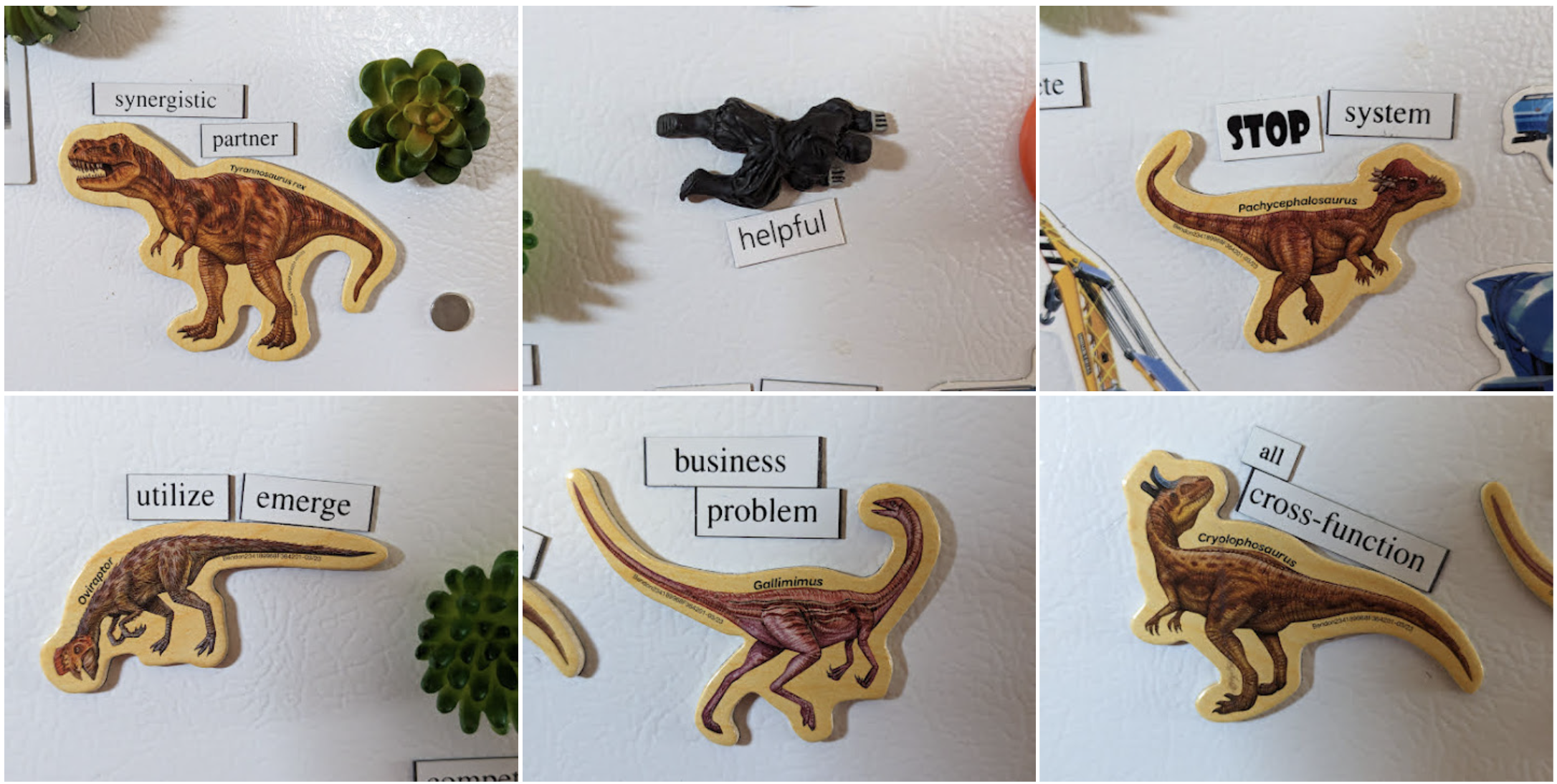First published as two emails, February 9, 2025.
My adventures continue! I've made it all the way West, to the ancestral manse (my parent's house) in Menlo Park, CA. I'm writing from my mom's art studio, the former garage. It is beautifully well-lit, with many surfaces for making, storing, sorting, and brainstorming. I am at the typing desk, looking out the window at the pink blossoms of a chinese fringe flower, Loropetalum chinese. A gardener's paradise, the Bay Area's ocean-moderated climate keeps many species perpetually in bloom, confused as to when the winter season comes and goes. On the drive up, as I passed through the Salinas River Valley, thousands of more sensitive trees had experienced January, and in February decided an end to 'winter', and were putting out huge silver shoots of new spring growth.
January
Rolling back the miles to last week, mid-Texas, the weather was Texas-Horrible - rainy and misty and in the mid-40s. Austin keeps growing. I drove through it two years ago, and two years before that, and visited for a big family gathering in the 2010s. I knew that the desert between the cities was filling up with sub-developments, but gosh, they just haven't stopped. As I approached Austin from East Texas, I encountered an Amazon distribution hub going up, as well as a wall-to-wall new subdivision, all in blue housewrap, fifty miles from the city center, on the eastern outskirts of Hutto, TX.
I visited my friend Jake, a pilot, lawyer, and miniature painter, and gifted him a very special space goblin, sculpted by legendary artist Kev Adams, the Goblinmaster. I received the goblin myself from the collection of Tom Barbellet, whose attic got (a little) emptied upon the birth of his daughters. Tom sent me a trove of little guys, from space marines to goblins to Colonial-America era forces, which I continue to draw from and deploy.
Jake, my Austin friend, is new to painting little guys (a pandemic era hobby) and has quickly surpassed my own skills. He's got an airbrush and a keen eye and he can do face details and I only make Ecce Mono faces. Here's how the Knightmare Miniatures Space Goblin turned out:
[Kev Adams' work comes from a very British, 1980s-and-1990s era of the hobby, and reflects deep lampooning of Thatcher-era culture. The result is characterful little goblins and orcs and squats and squigs which have withstood decades as much-beloved best-in-class little guys. It was a joy to be able to pass these small treasures from one collector to another].
Jake and I ate at tacodeli, which is amazing, and then I pressed north towards Glen Rose, Texas and the Dinosaur Valley.
Dinosaur Valley
140-100 million years ago, North America was riven by an inland ocean, filling in central Canada, the American midwest and the Mississippi delta. Central Texas was at that time the easternmost peninsula of Western North America, a strand out into the shallow ocean between the Rockies and the Appalachians. Since then, the ocean levels have fallen, the land has risen, and the Midwest has been filled in with sediment from the decaying Appalachian mountains, the Canadian glaciation, and other forces. A modern river, the Paluxy River, carves through the Glen Rose Formation, revealing tracks and traces pressed into the mud of ancient shores and riverbanks. A horseshoe bend has been reserved as Dinosaur Valley State Park, and it holds for the public to view numerous sites which the river has revealed: the footprints of carnivore dinosaurs, herbivores in an enormous dance, hunting traces, and other trackways. These chance fossilizations are representative of millions of years of animal activity in this place, with the final mud prints from one rainy season being filled in by flood sediment at the start of the next.
A footprint of an Acrocanthosaurus, a bipedal predator dinosaur related to Allosaurus, about 30 feet long, with huge neural spines above its backbone. My hand is a few feet above the fossil impression - the creature left a print four to six inches deep, and two feet in length from heel to central toe.
I've seen lots of animal tracks out in nature, from the little human hands of raccoons to squiggles of a lizard's brushing tail, and to my eye, except for the millions-of-years-of-preservation-as-rock, these were clearly traces of a moving, living animal. I can't undersell how real dinosaurs feel when you can see their gait, think through the impressions their feet make in the mud, follow a line and know that just one individual creature laid this track down, so far back in time. I have believed for my whole life that dinosaurs existed, but now I know in my felt experience that they did. I've seen their physical traces, miraculously preserved.
This nuanced feeling of a hobby naturalist is something I appreciate here in adulthood, but I can see how a bunch of hiking trails in a hot Texas riverbed are not exciting for the youth. And so Dinosaur Valley provides, with a for-profit establishment just down the road called Dinosaur World. This is a gift shop with a garden of fiberglass statues behind it, a tourist trap of the highest order. I had to go in, and I did!
A colony of yucca plants adjacent to a fiberglass dimetrodon. A half mile path brought one wandering through the chaparral.
The area is designed for families, and is usually full, and loud. But not on this rainy weekday morning in late January! I was the only guest, and so I just got to calmly walk among the dinosaur friends. With the light rain (or heavy mist), and the pines and cedars around, some of the still scenes did have real magic and majesty. I was especially impressed by the huge sauropods adjacent to the lagoon, and their cousins walking across the misty mesquite savannah.
Sauropods (perhaps Sauroposeidon) in the mist.
More photographs from Dinosaur World:
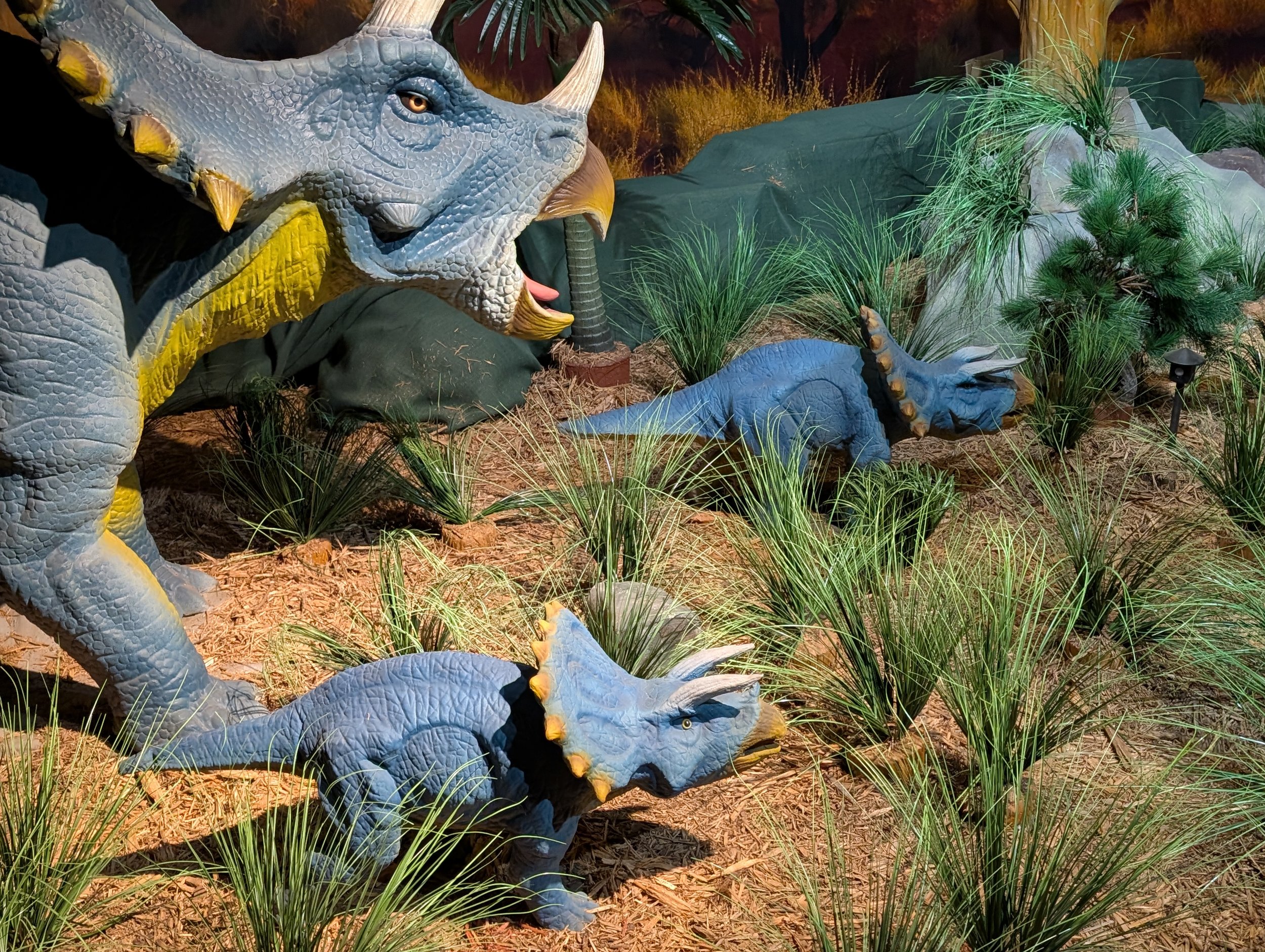
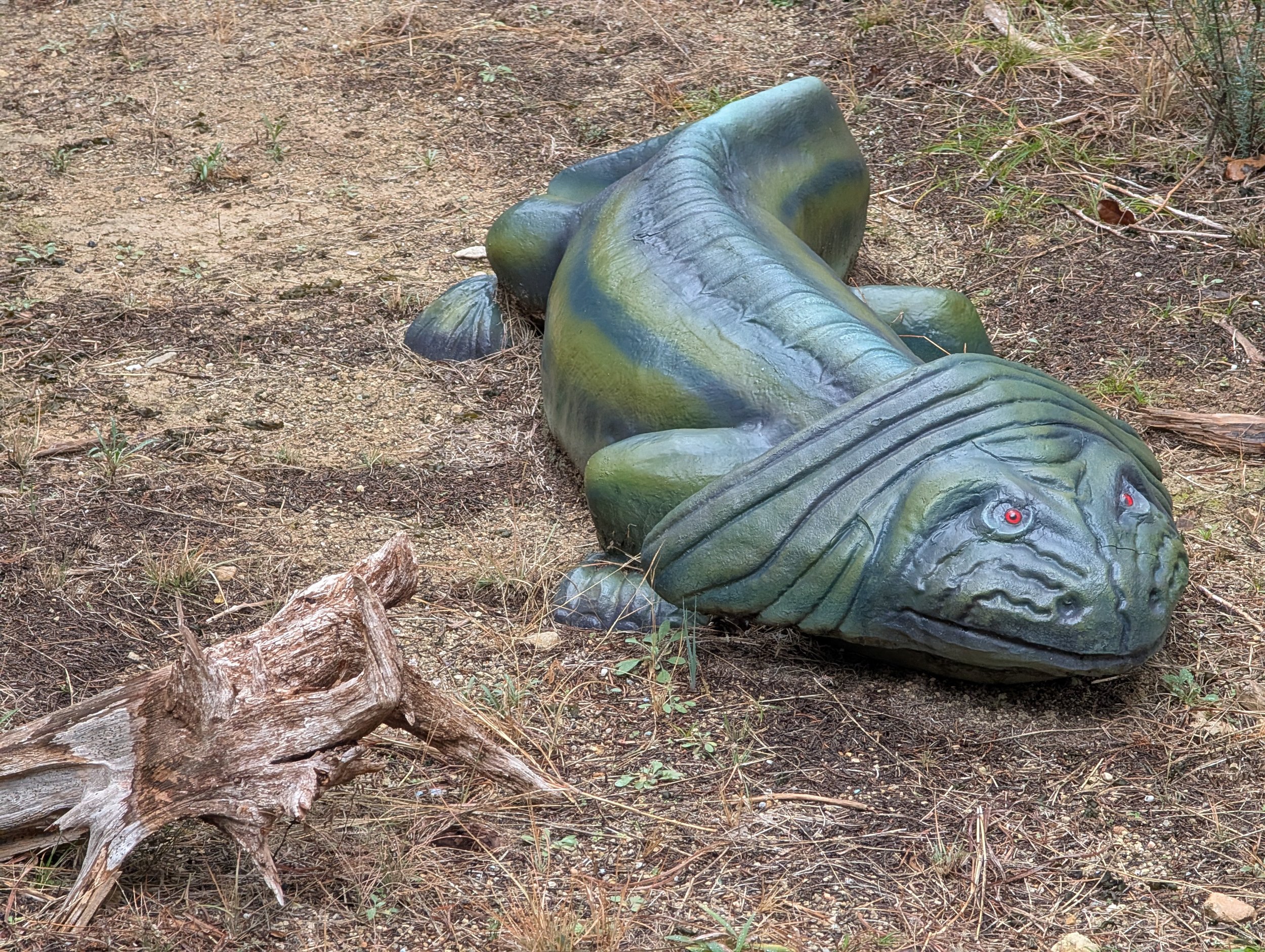
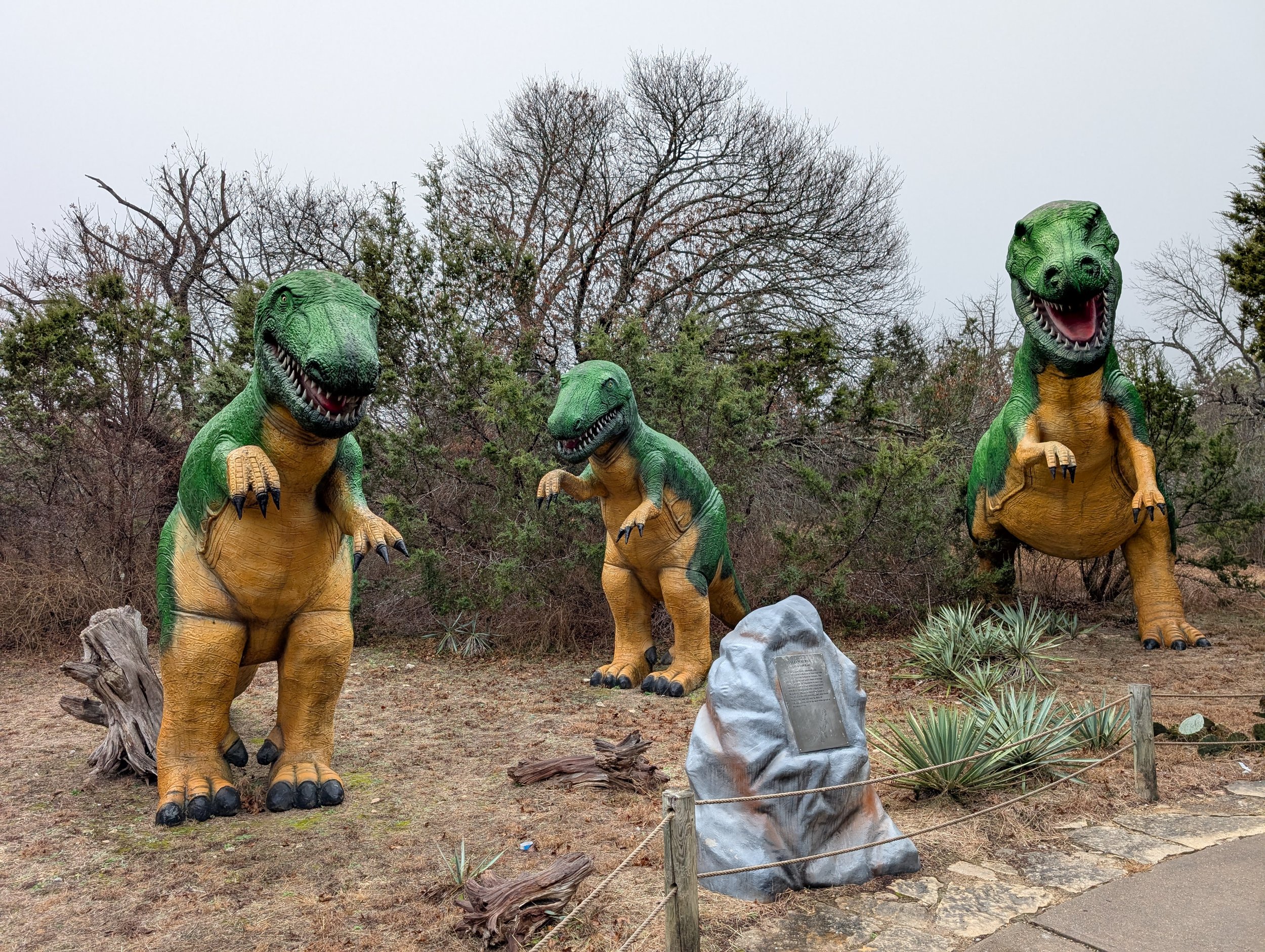
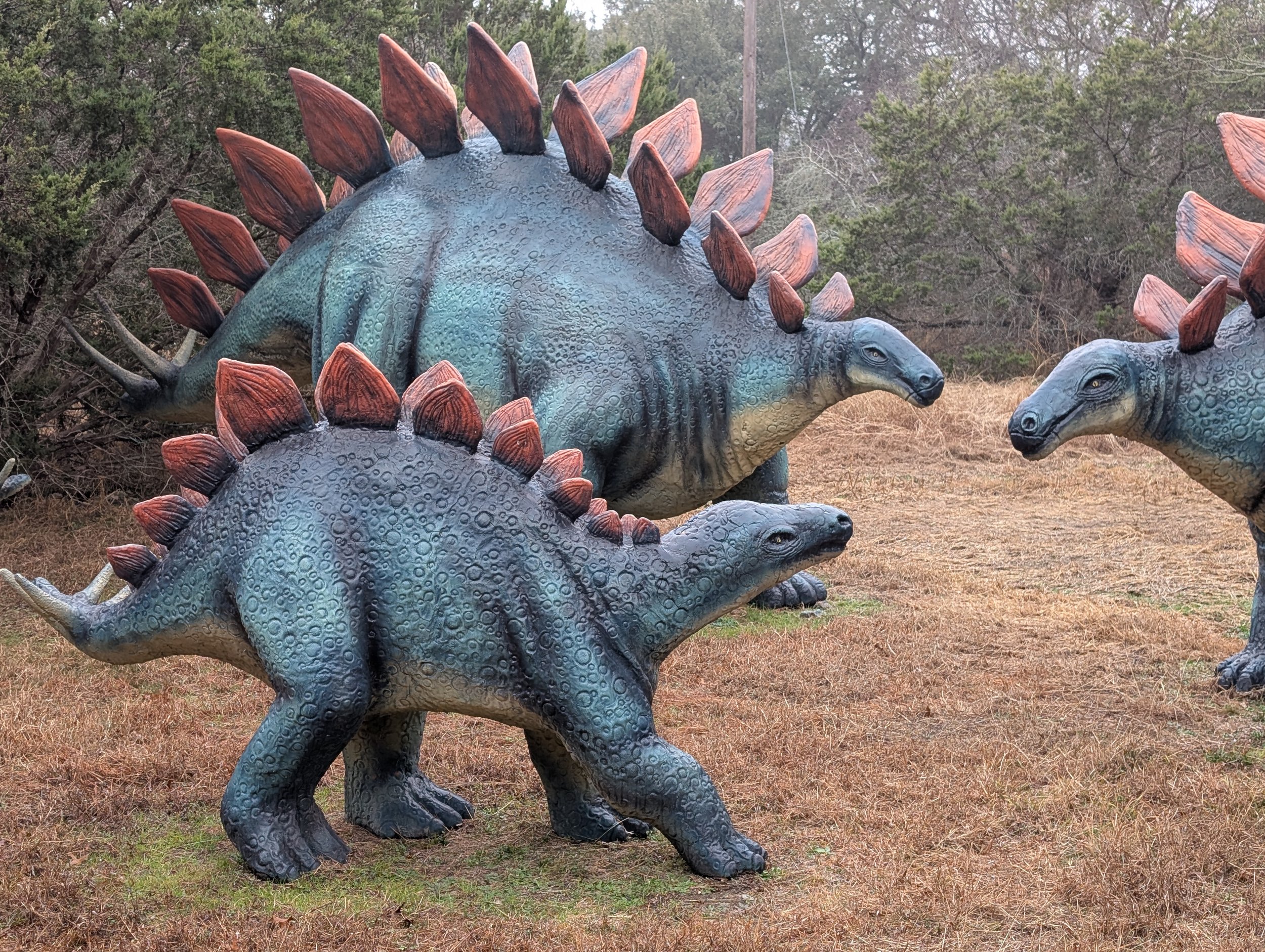
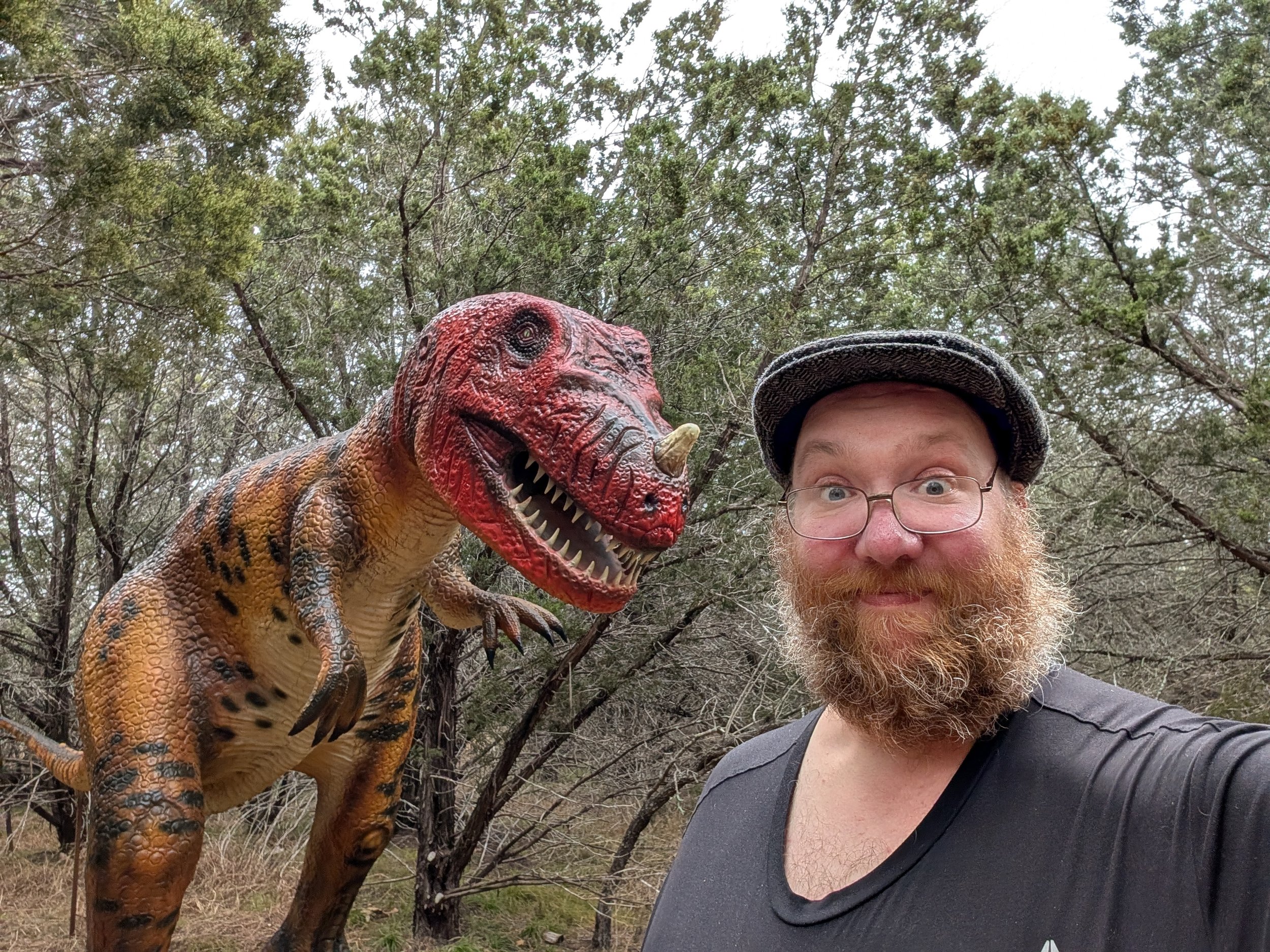
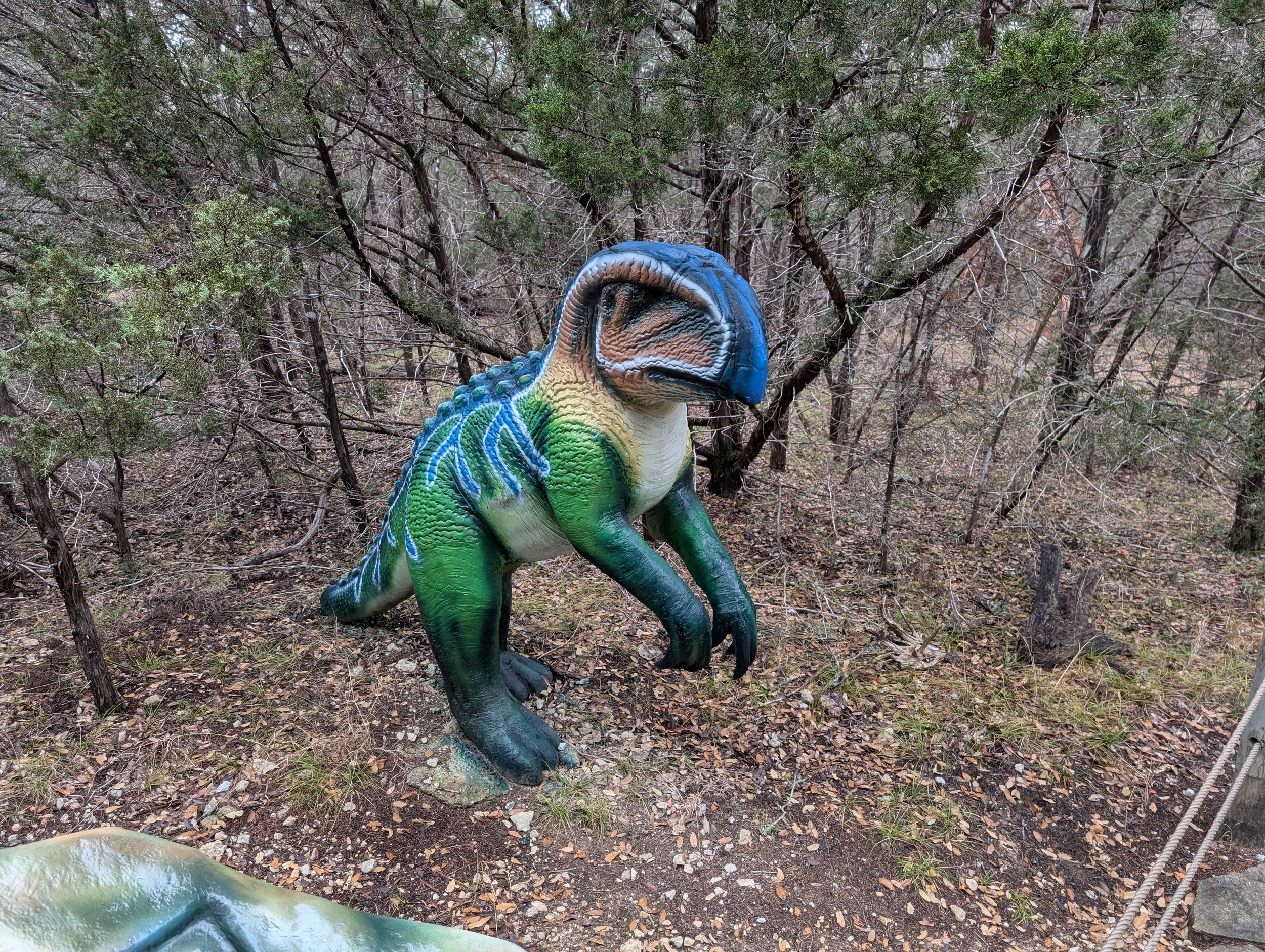
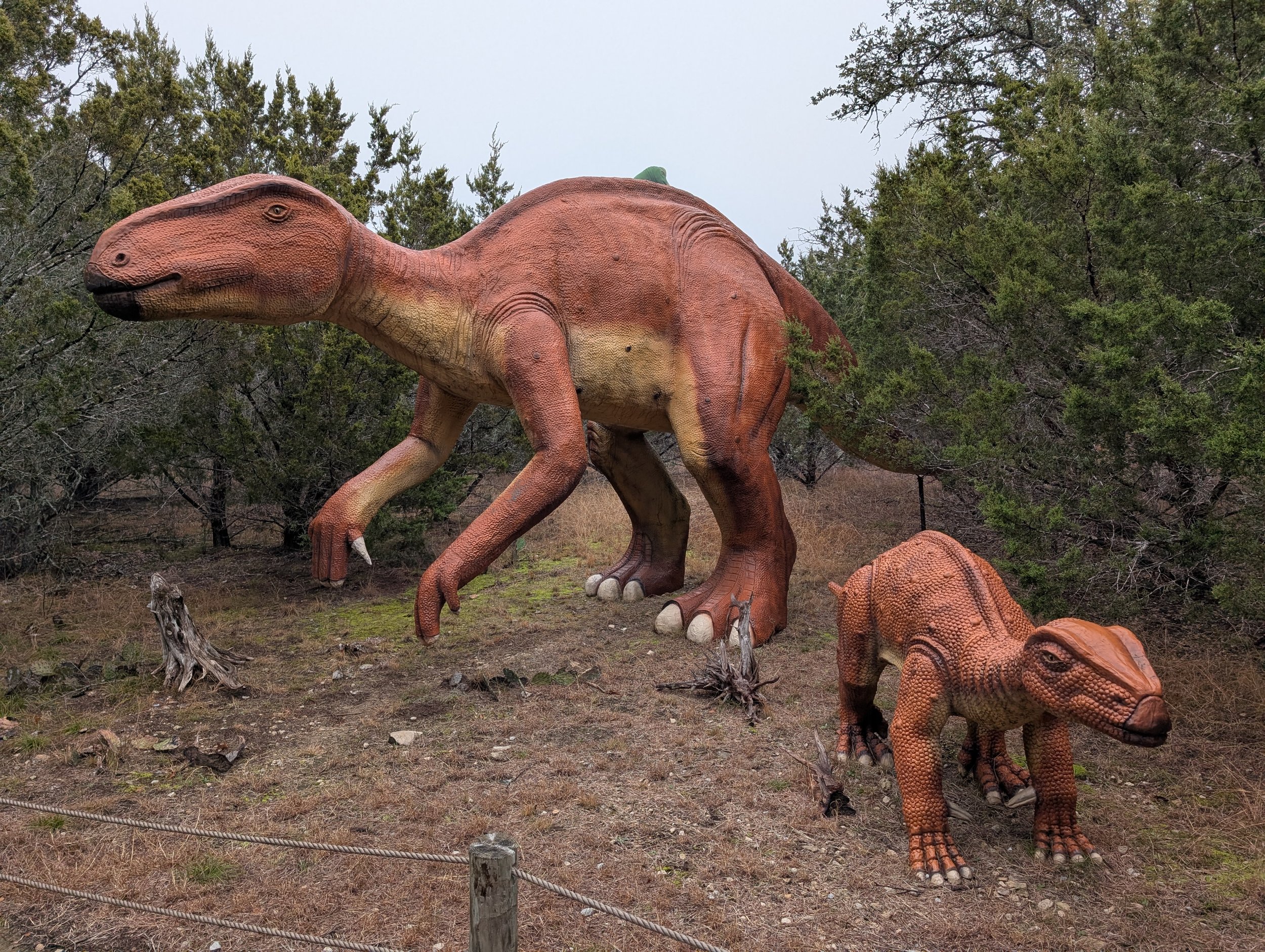
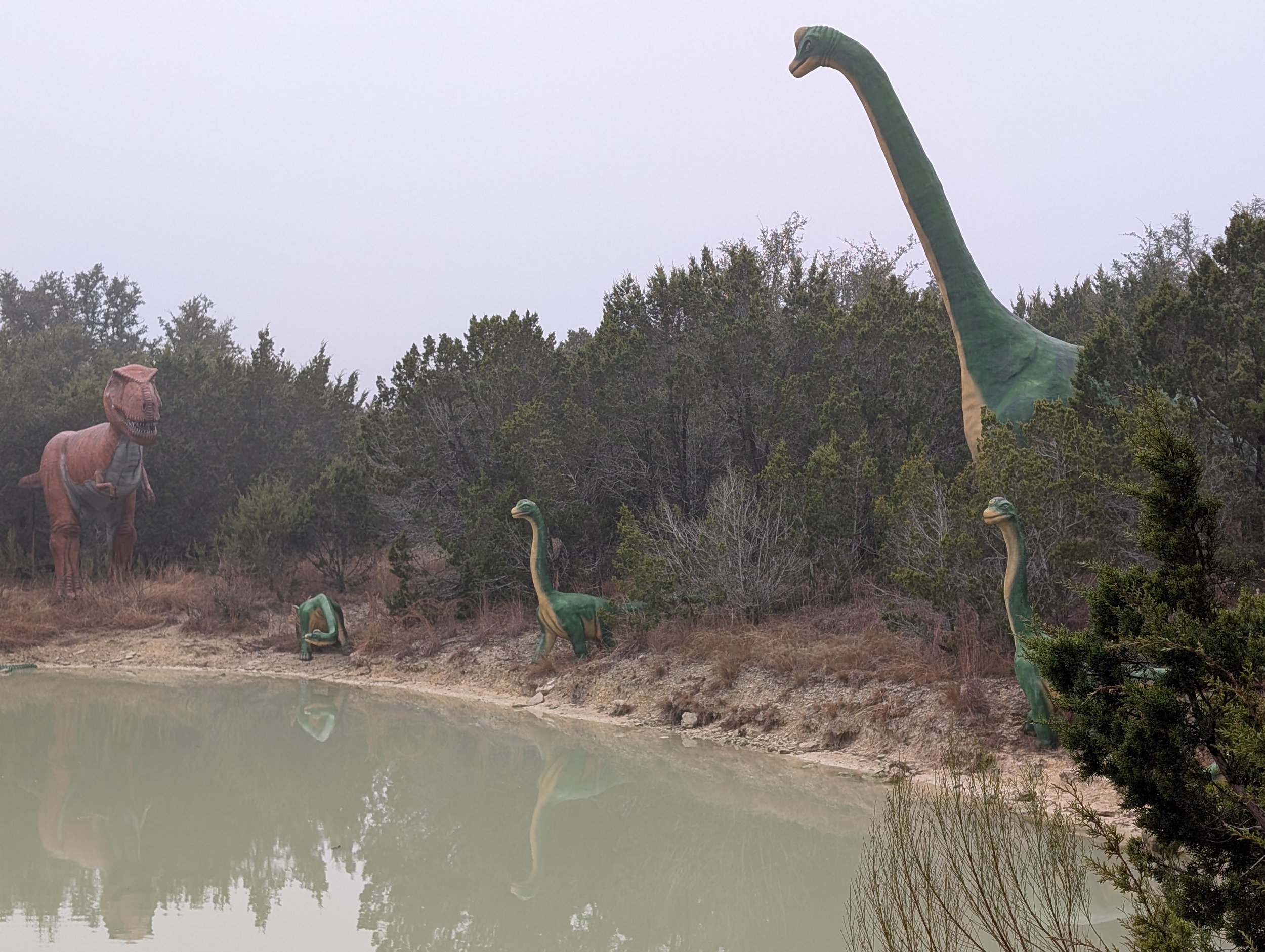
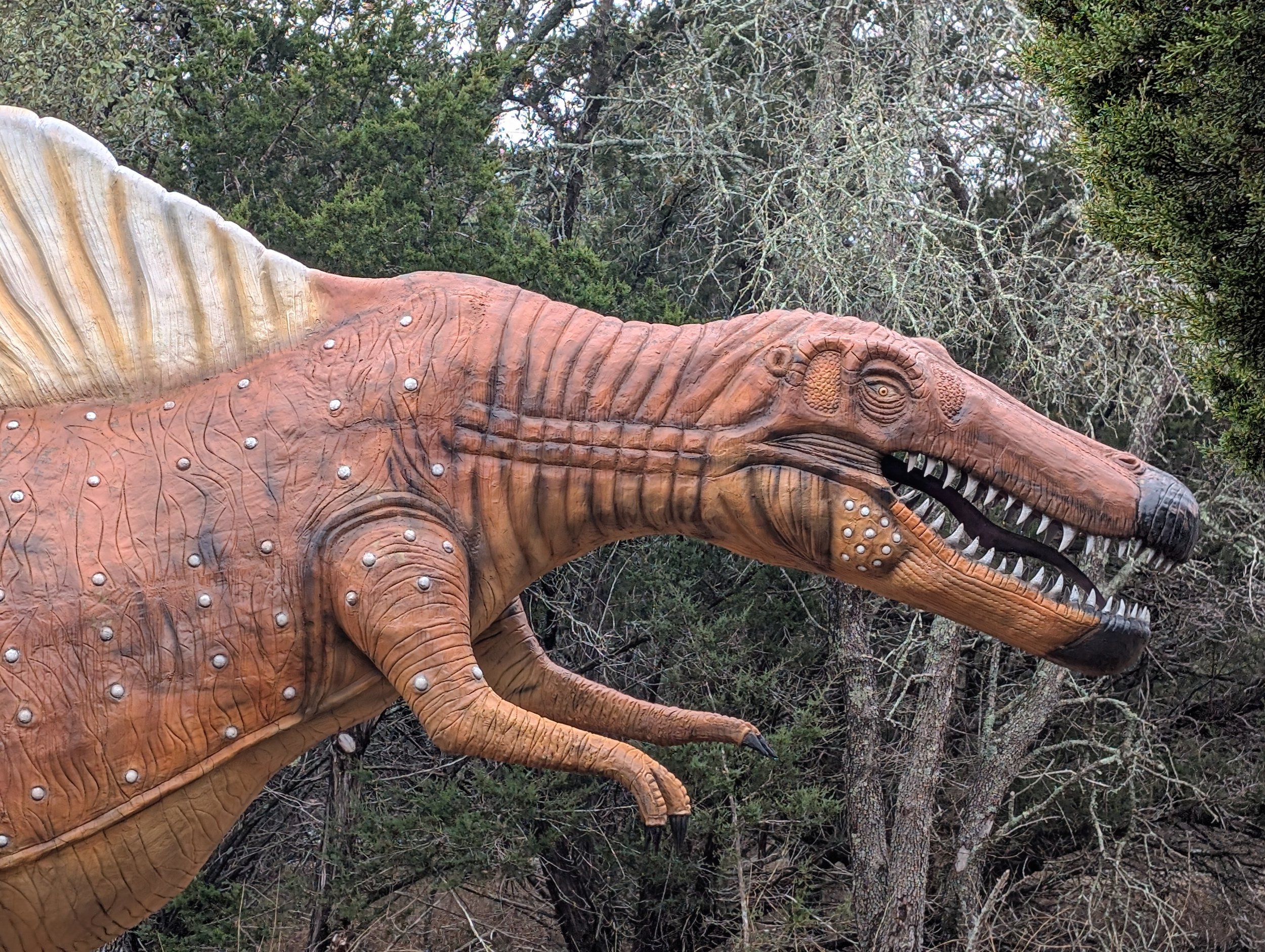
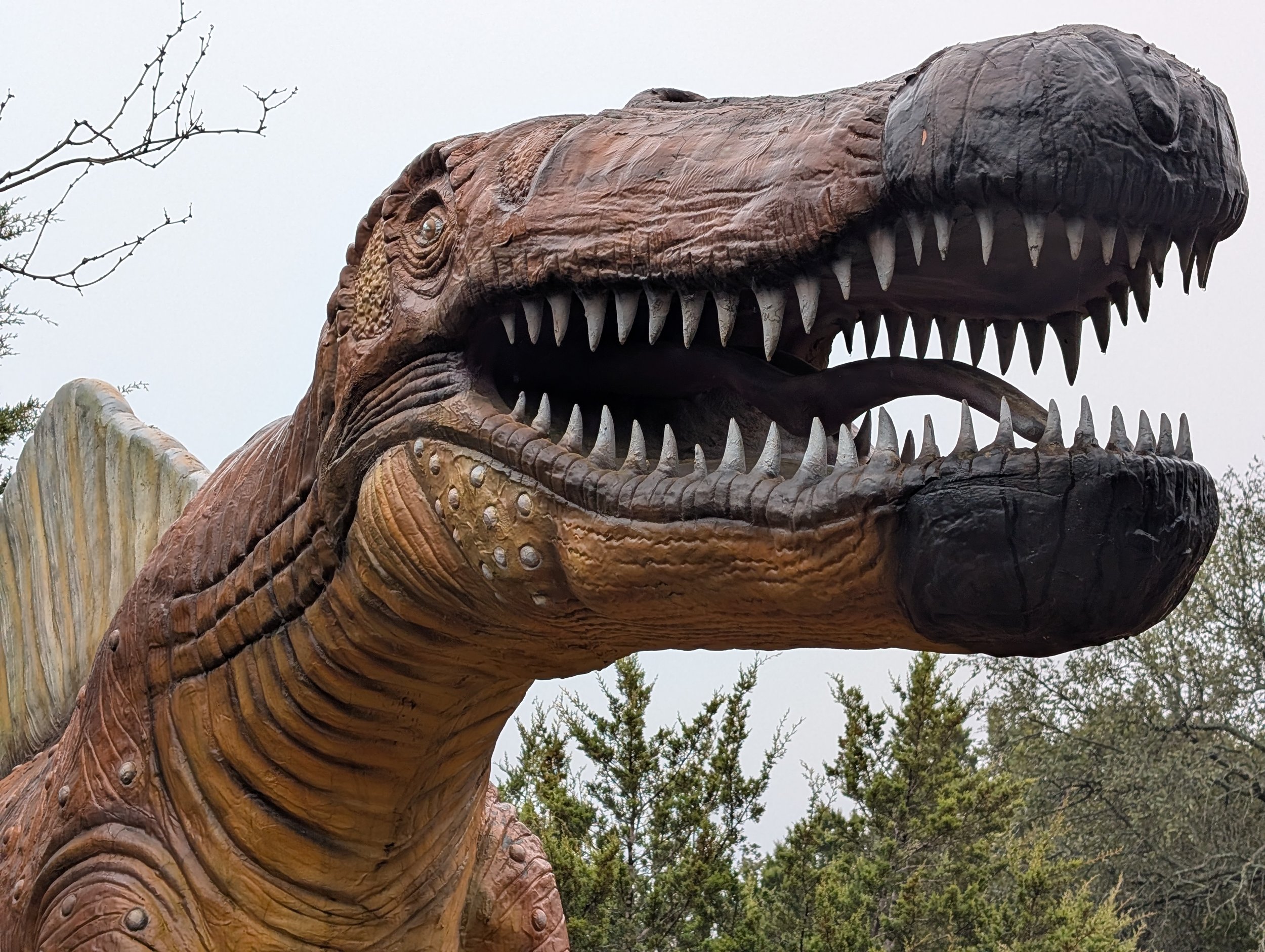
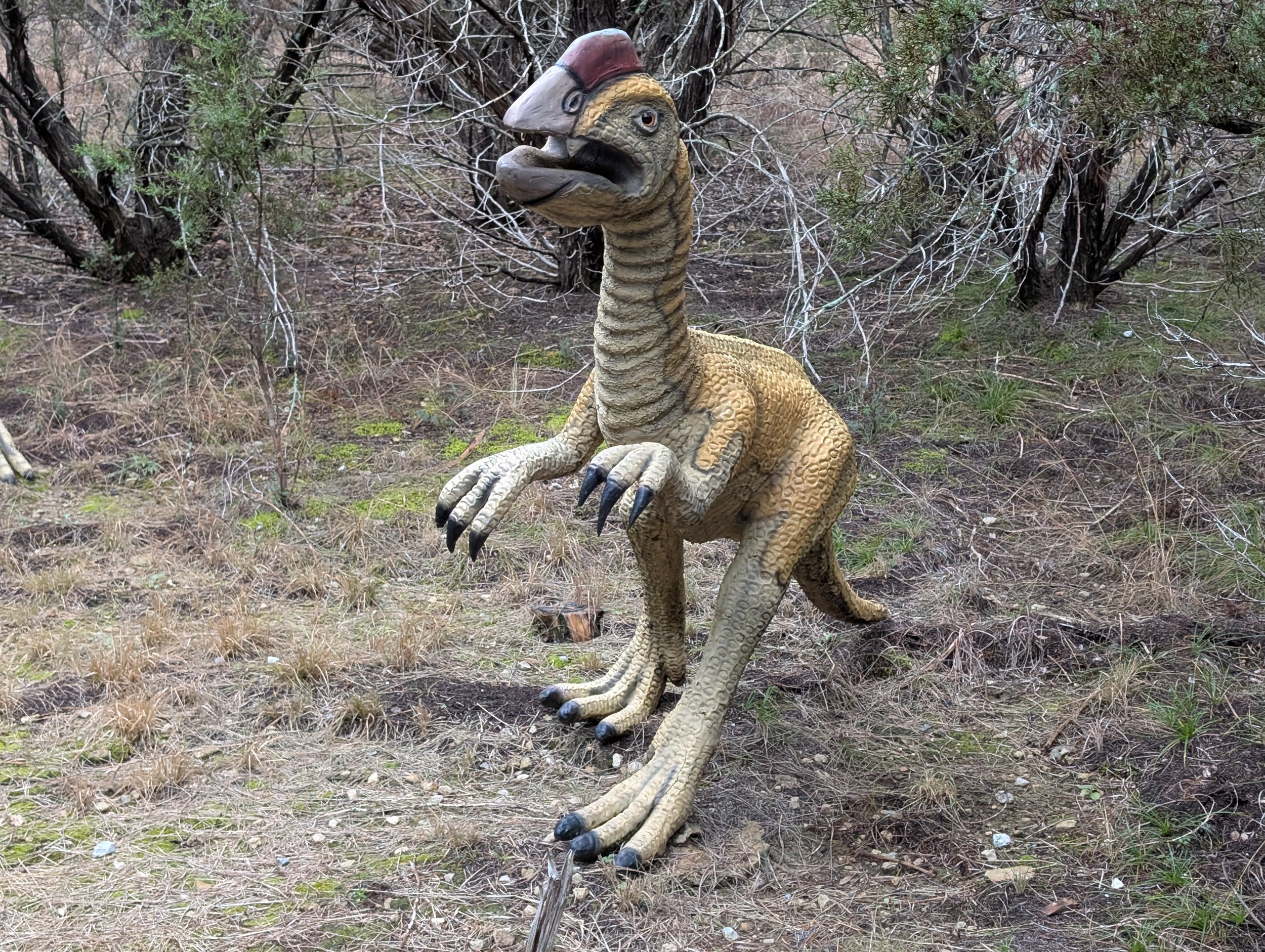
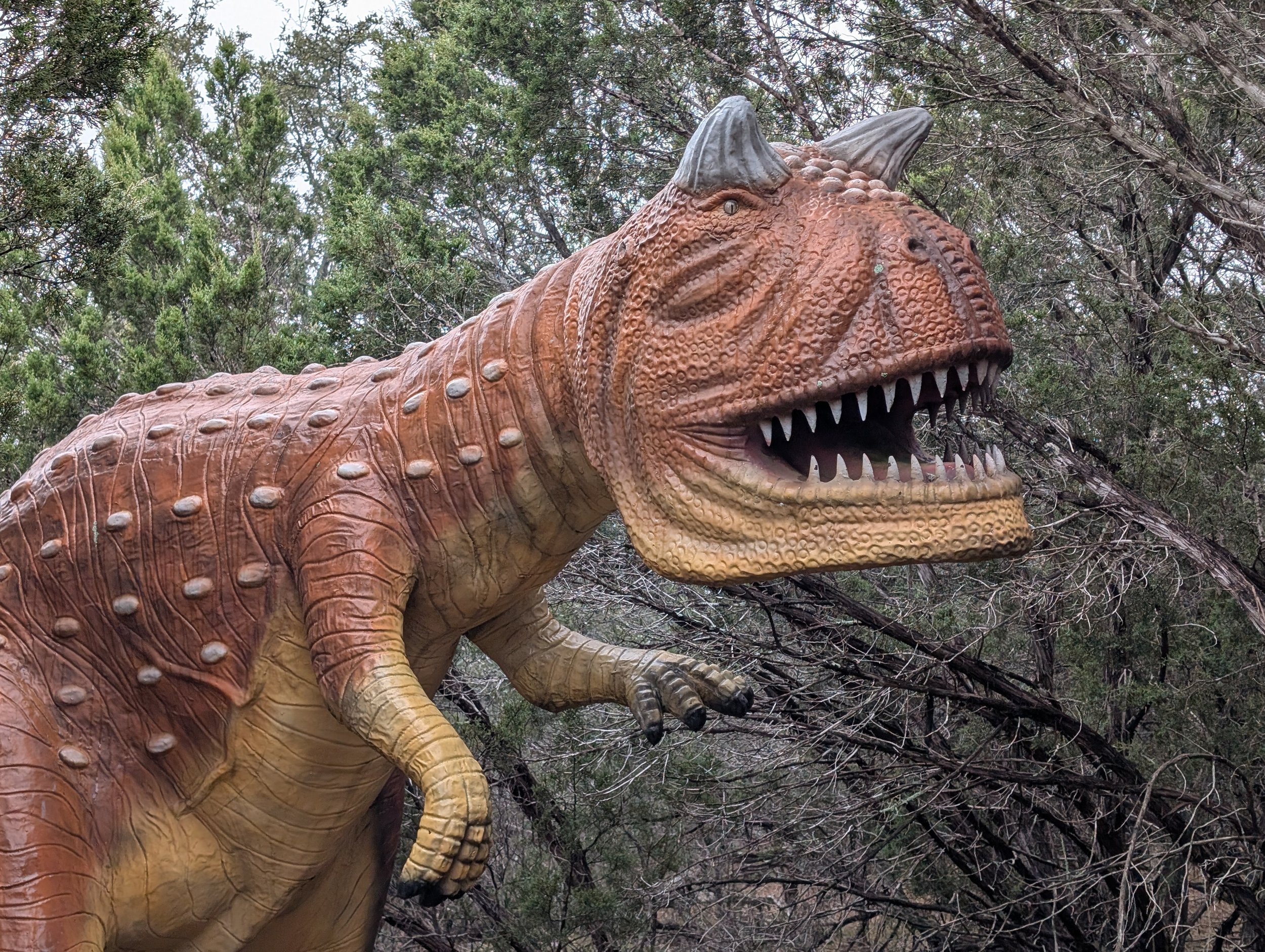
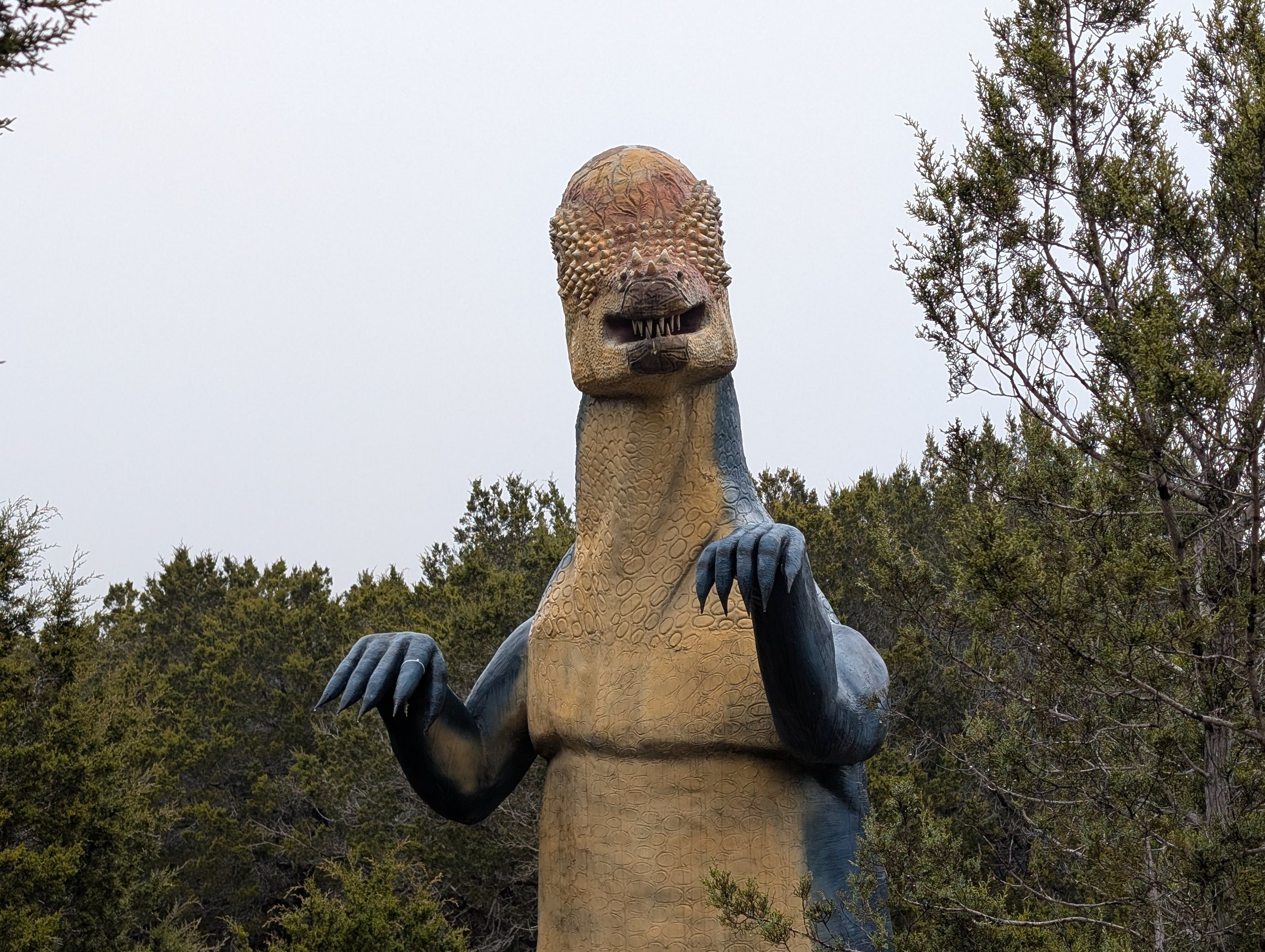
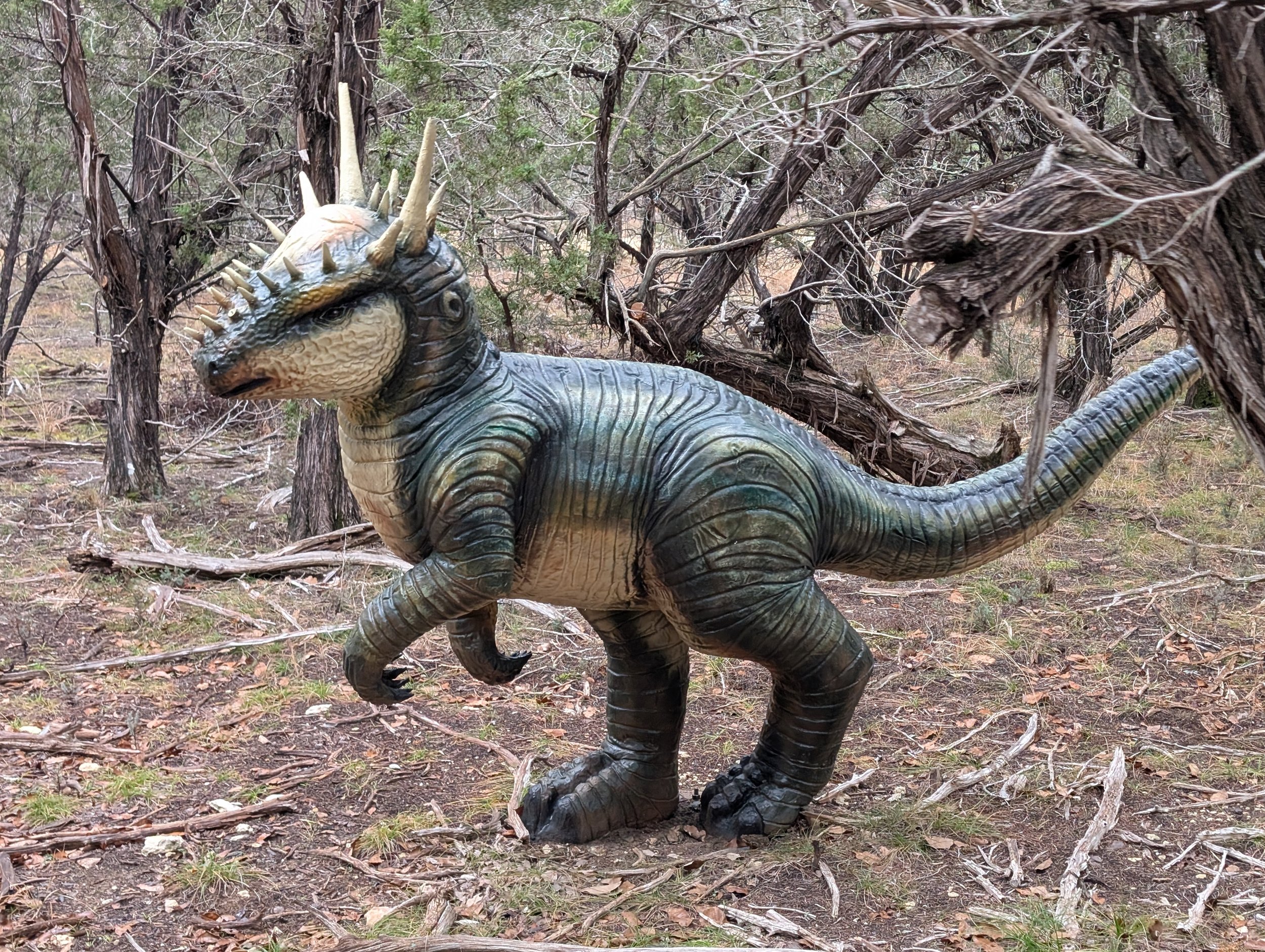


From there, I headed West, through the part of central Texas called the Permian Basin. It's a burned over land: Jesus is everywhere, even the coffee shops.
This was hundreds of miles of energy extraction: oil fields, chemical plants, industrial agriculture, and temporary housing. The most impressive and strange housing I passed was an Armadillo Hotel, a chain focused on 'the Permian Traveller', made out of a stack of prefabricated structures pulled onto site and turned into rows of mass worker housing.
While it has been known since its 70s heyday as the 'Texas Oil Fields', hydraulic fracturing and horizontal drilling have allowed for the same fields to be extracted in new ways, pulling natural gas and other hydrocarbons, and bringing the area into as much activity today as there was fifty years ago. Natural gas is so cheap that [I saw] many concentrating operations with enormous flares burning in the fog - burning off the 'excess' gas off rather than spending the further money to bring it into the energy grid. The area produces a fifth of the nation's oil, and a twelfth of its natural gas.
I drove through on an extremely foggy day, to the point that things got monochromatic.
Carlsbad Caverns
[Note the other guests in the cave, left of center, for scale.]
As I travelled from the Gulf Coast into West Texas and the Southwest States, I went up in altitude a few thousand feet. It can be hard to visualize how much earth must mound upon itself to create highland regions. A mile of rock? How do you even visualize that? Carlsbad Caverns is one of the country's largest show caves, about six football fields by area. Its volume was hard to fathom - the Big Room is 4,000 ft x 625 ft x 255 ft high.
The caves are formed inside the Capitan Reef, a calcium structure formed by the shallow seas 250 million years ago, and then lifted into the high desert by tectonic forces. It's been hollowed by hydrogen sulphide seeping up, and now limestone and rainwater leak down. The cave environment has been open to the air for tens of thousands of years, and it is home to huge swarms of bats, which migrate in and out the natural entrances.
I skipped a lot of that - I took the elevator.
It's worth a visit to Carlsbad in your lifetime, and it's a National Park - you already pay for its upkeep!
After visiting the Caverns, I took a steep drive over the Sacramento Mountains, to Alamogordo, NM, and then slipped across the Arizona border the next morning, Tucson in my mind.
February
My adventures across the Sunbelt continue in this email, and on my website here, where there are many more photographs than these emails can handle.
The Rock Yard
Some of the available wares on the ‘show floor’.
Tucson, Arizona is known for its annual Gem Show. This is a misnomer - the 'gem show' is a federation of simultaneous shows and business open houses, not one centrally organized event. There are some big events and venues in town - the biggest are limited to registered gem dealers (IE, local gem shops and jewelry-makers around the country) and cost money to attend. But many of Tuscon's private businesses are just ... open! For the whole week or two of early February each year. One of those places, which I scouted two years ago (two weeks too late), was open when I drove through- the Rock Yard!
via Google Maps’ 3D interpolation.
It isn't much to look at - a dusty square courtyard in front of a blue metal building, but the pallets of barrels of material are worth a thousand mile drive. The business sources all kinds of interesting geology from around the world at prices that make you gasp (compared to the inflated price per piece in retail rock shops), and sells it by the pound, in a way I find charmingly functional and efficient. No big advertising, no pristine showroom, not even weather protection. Rocks ready to be moved for money.
Felicity, California - Center of the World
The sign for the website for the location where the sign is.
Speaking of rocks for money, Felicity, California is an enterprising young town (founded in the 1980s!) which has gotten itself registered as the Official Center of the World. How? Well, they've built a granite pyramid, and a series of historical monuments, and a gift shop, and they wrote a children's book.
Which officials have claimed Felicity as the Official Center of the World? Well, no one less prestigious than the Imperial County Board of Supervisors! After reading about it in a children's book (by the town's founder), they declared it true!
The Center of the World has become a granite monument creation engine. The big pyramid is surrounded by eight cardinal plinth-walls, the Museum of History in Granite. Another twelve long plinths are built around the eight. Many surfaces await subject matter, for the right donation of course.
Among A Host of Subjects
Timekeeping Evolution of Mankind The Crusades Dynasties Energy Use & Innovation Hundred Years War Languages The Middle Ages Navigation Philosophy The Renaissance The Roman Empire World Religions Numbers Early Music
[Emphasis mine. It is not a balanced diet of history, yet, but babe, look, the Roman Empire!]
One can also be remembered and preserved in the Maze of Honor, a series of interlocking granite curves, lined with square plaques commemorating all sorts of events, from birthdays to graduations to general messages. You can get one too, for $500 on this online form.
I drove through town pretty early in the morning, especially since at this time of year Arizona clocks run an hour later than Californian ones, and Felicity is right near the state border. Nothing was open at the Center of the World complex, there were signs requesting an entrance fee for the whole property (parking lot included), and the town itself was small and sleepy, so I took the photo above and pressed on. So long, Center of Earth! Maybe your charms will be successful on a less early riser.
Slab City
I am out of weed.
The Last Free Place in America. Some folks in the country would call this decrepit air force base area the real Center of the World. Slab City is on the Eastern shore of the Salton Sea, a recent, accidental inland ocean which is rapidly shrinking. Both are in California's Imperial Valley, a basin which is mostly below modern sea levels, with Salton as its lowest point (and where excavatable quantities of salt were deposited in the geologic past, when previous inland oceans dried up). Don't worry - I will write more about the former town of Salton later in this email.
Slab City's residents don't want governance, or oversight, or help. They went out and started living in former Air Force land to get away from all that. It isn't pleasant out there. The base was built at the foot of small mountains of the Colorado Desert, and the grid of once-paved streets is riven with washes where the very occasional rain courses across the site. There are soapbushes and cacti and thornscrub everywhere, but they provide little relief from the sun. The place smells like dry human waste, dead fish, and salt. The air is full of fine dust from the lakebed.
Residents arrange themselves into camps. There are landmarks everywhere - there's not much to do but make art out there. It used to be further out of town, but the towns in the Imperial Valley have been growing. There are four Walmarts south of the Salton Sea! Los Angeles spills well beyond Redlands, pushing people into inhabiting the abandoned resort towns around the salty lake. Civilization encroaches - there may not be police present (or welcome), but Google Maps lists every single camp and art piece and secret temple by name, many with gossipy reviews.
As another resident advised me, "It's the Slabs, bro. Everything is temporary." A tableau from inside the antechamber art pieces of the House of Dots.
I visited Flamingo Camp, a stable fixture of queer-accepting folks whose camp is centered around a snack bar bus situation, and I toured the nearby House of Dots, with Dot, the proprietor. We exchanged some small dinosaurs and costume jewelry for our various art missions. She's friendly and very funny and gives a great tour talk.
The outskirts of East Jesus.
I cannot stress how exposed one is out on the Slabs. It is hot. It is dry. The air quality is disrupted by a century of bizarre human mismanagement (see below). The area is called the Colorado Desert but in the geologic past it has been the Colorado Delta, with the Colorado river reaching its natural extent and making the place a swampy marsh before exiting into the Gulf of California.
One really has to want to live out here, to have a strong desire to be away from People with a capital P. The camps I visited are well-known and well-marked. Other residents stay much more private and do not wish for visitors. There are folks like this deep in Appalachia, too, and so I know well enough to let go of my desire to connect and just let them be them.
I did stop at an avowed tourist attraction, the art piece which drew folks to the site. Salvation Mountain is an enormous straw-and-cement-and-mortar enterprise in land art or massive messaging, the legacy of one artistic, religious man, Leonard Knight.
The structure is efficient in its materials - empty paint cans form decorative ranks at the base of the landscape.
Salvation Mountain has outlasted its creator, and is shepharded now by a non profit organization. There was an attendant volunteer on site, a young man with a big straw hat giving tours of the different areas - a shrine to the southern end, a collapsed ship-building designed originally in the image of a different collapsed vehicle.
Superior Quality Papa Selfie
Even in winter, it was hot out there, and without the kind of sun preparation one needs to survive out there, my cat and I were quickly oven-baked by the area and ready to move on in air conditioned, polarized-glass comfort.
Salton City, The Salton Sea
Bales placed to trap fine particles of dust, promote plant growth in their wind-shadows, and generally stabilize the new beach-area. The sea is visible as the bottom half of the blue haze of the sky. On more clear days, the other shore and the mountains beyond are visible.
The Salton Sea is so weird. In the early 1900s, when building the initial canals to divert the Colorado River towards Los Angeles and the Imperial Valley, a canal structure broke and took two years to repair, leaking river water out onto the salt flats the whole time. The mining town of Salton was swallowed up. A lake formed, and by the 1930s communities began to settle around it, attracted by the birds and fish which had also arrived at the lake. That same river water continues to feed the Salton Sea, though it now is sent by canal to the agricultural districts that surround the Sea. The agricultural runoff is directed to the New River, which then feeds the Sea.
Spreckles Sugar Factory, Imperial Valley. Note the Sea Level marking halfway up the tower. The Salton Sea itself is another 200 feet lower than this land to its south.
Because the whole place is in a basin below sea level, the Sea never drains, it just evaporates (and concentrates). Over the last fifty years, it has grown increasingly salty and toxic, resulting in a huge die-off of the fish which once swarmed the lake, a reduction in the visiting birds, and other ill effects.
I visited in 2009 and when I did, the wharf from which I took the photograph above was just fifty feet from the shoreline, and it was a foot deep in fish bones. Since then, there have been enormous legal battles about water rights and water usage, state propositions enacted, and a natural remediation strategy implemented.
Now, the shore line is a thousand feet away. There are tens of thousands of bales of hay deployed to keep the dust down and encourage local plants to take root in the lees. It felt like its own kind of Land Art installation - a human intervention whose results are not yet known.
We will spend the coming century answering the questions of what to do with the Salton Sea, how to do it, and whether we have the willpower to effect such a plan. To answer those questions we have to ask what we intend to do with the Colorado River, the Pacific Ocean, greater Los Angeles, and the multiple Mexican states just across the human border. And we'll have to do it together - the scale of our errors here goes well beyond individual action.
As I mentioned at the start of Part One, I've made it to Northern California from there. I have a few more adventures to describe in Los Angeles, but they will have to wait until the next Dispatch.
Thank you for reading these long emails (or this long blog post). I know that the Vacation Slideshow is a format with mixed reception, but if you made it this far you clearly enjoy Vacation Slideshows, and I salute you for it!
Warm regards from Menlo Park,
Connor Sites-Bowen


































































